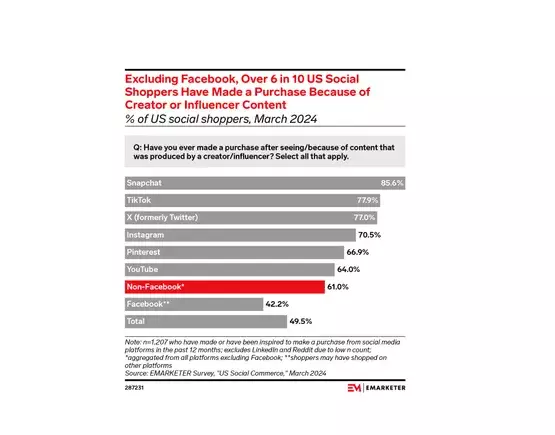A recent analysis has brought to light Snapchat’s remarkable effectiveness in influencing consumer buying decisions, particularly through influencer-generated content. According to findings from an eMarketer survey, a staggering 85.6% of Snapchat users confirmed they made purchases after viewing products showcased by creators on the platform. This noteworthy statistic positions Snapchat as the frontrunner in the realm of social shopping, outpacing its competitors, including TikTok, Instagram, and even the video powerhouse YouTube.
The results are particularly intriguing in light of the large followings commanded by prominent YouTube creators such as MrBeast and Logan Paul, who have successfully launched their retail ventures, seemingly fueled by their digital presence. The contrast between these established figures and Snapchat’s effectiveness underscores a shift in consumer behavior that revolves around the platform’s unique blend of intimacy and trust. Users engage with Snapchat in a way that feels distinctly personal, likely amplifying the impact of influencer recommendations.
The survey further segments purchasing behavior by generational demographics, revealing that Gen Z consumers—aged primarily between 15 and 26—are particularly susceptible to influencer recommendations on Snapchat, with a commendable 82.0% reporting that they have made purchases linked to creator content. This trend starkly contrasts with the more traditional Baby Boomer generation, where only 18.8% were influenced to buy based on similar content.
Interestingly, Gen X shoppers also showed a significant interaction with influencer marketing, with 40.8% stating they made purchases based on creator content. This unexpected engagement from Gen X hints at a broader acceptance of influencer-driven marketing across various age groups, suggesting that the influence of social media extends beyond the youth market.
Contrastingly, Facebook’s performance in this domain seems to fall flat, recording the lowest engagement in terms of purchases driven by creators. This lackluster response can be attributed to Facebook’s structure, which does not typically foster the same type of dynamic creator-consumer relationships that platforms like Snapchat enable. The findings suggest that while Facebook may boast a vast user base, it struggles to convert that audience into consumers driven by influencer recommendations.
This revelation beckons marketers and brands to re-evaluate the platforms on which they invest their influencer marketing efforts. As Snapchat solidifies its position as a key player in social commerce, the landscape calls for a strategic realignment toward channels that effectively engage and convert audiences.
Given Snapchat’s substantial influence on consumer behavior, particularly among younger demographics, brands should consider strategically aligning with relevant influencers on the platform. Snapchatters have shown a progressive inclination toward online shopping, which presents a ripe opportunity for brands to leverage this trust-based consumer engagement.
As influencer marketing continues to evolve, the need to identify and align with the right platforms is critical for maximizing campaign effectiveness. Snapchat stands out not only as a medium for disseminating marketing messages but as a potent driver of purchase decisions, particularly among a generation that thrives on connection and authenticity. For brands aiming to thrive in the fast-evolving social commerce space, Snapchat’s growing influence highlights an essential avenue for engagement and conversion, signaling a clear directive for future marketing endeavors.


Leave a Reply
You must be logged in to post a comment.